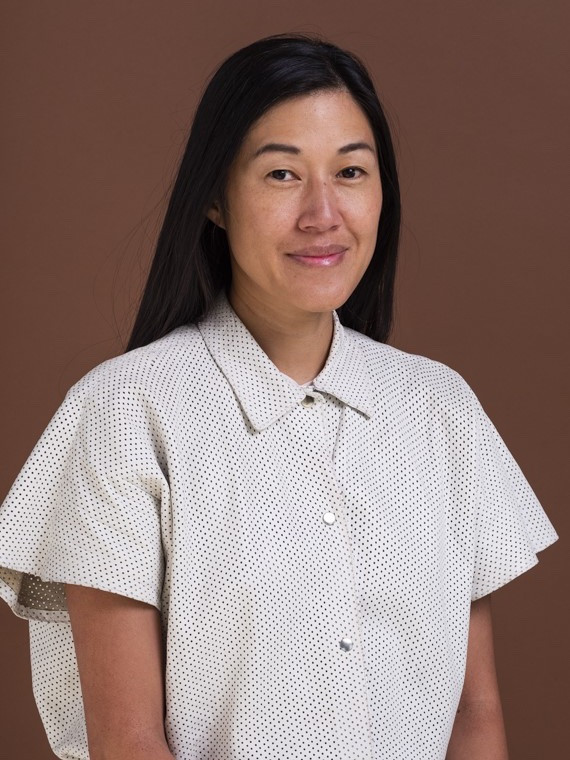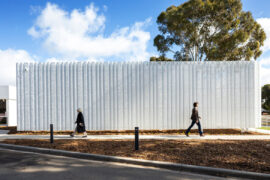In part two of our series covering Sibling Architecture’s New Agency research, IndesignLive talks with Sibling directors Timothy Moore and Qianyi Lim to discuss intergenerational housing.

November 12th, 2021
Sibling Architecture has released New Agency, a concise compendium of the housing troubles facing future generations and ageing populations in Australia, based on three years worth of research.
In part two of our series discussing this research with Sibling, IndesignLive talked to Sibling directors Timothy Moore and Qianyi Lim to discuss forms of intergenerational housing.

Qianyi Lim. Photography by James Whiting.
In Australia, intergenerational housing is “framed as this thing that’s just been discovered,” says Lim, “but its been happening in other cultures for a very long time”.
“In Australia, there is a rise of multi generational housing that’s happening, which is really driven by the diasporic communities of China and India,” says Moore.

Timothy Moore. Photography by James Whiting.
“It’s also driven by the cost of housing here as well. You’ll find that younger people still living at home for longer, just simply because it costs so much to be renting or to even consider purchasing a home,” adds Lim.
Sibling Architecture took a look around the world to draw inspiration from international sources that would ultimately inspire its “radical” solution to ensuring fair, accessible housing.
The following is an excerpt from Sibling Architecture’s research New Agency.
Forms of intergenerational connection
Babayaga House

A graphic from Sibling Architecture’s New Agency publication.
Babayaga is a self-initiated co-housing project for elderly women in Paris. A case was presented to the government that money over time would be saved by investing in the construction of the housing arrangement, since residents would not have to rely on state-run homes. The project was developed with 8 different government agencies, which contributed funds for the development.
The apartment building has 25 flats: 21 for the elderly, 4 for students. Residents contribute 10 hours to household chores a week, alleviating need for care workers. The ground floor is social space that connects to the wider community.
In Australia, women on average retire with half as much superannuation as men; women over the age of 50 are the fastest growing group of homeless people in Australia. Could the Babayaga model inspire a new self-governed methodology of housing for groups such as ageing women?
Yoro Shisetsu: Kotoen
Yoro Shisetsu, a ‘facility for young and old’, refers to joint aged- and child-care facilities first developed in Japan in the late 1970s as it was facing the challenge of an ageing population.
Due to post-war poverty, aged care facilities became a necessary part of social services and were supported by the government or philanthropy. In Japan, these were stigmatised as it was counter to the cultural tradition of filial piety.
The first joint aged- and child-care facility called Kotoen is still in operation today. Originally, the Kotoen aged-care facility was adjacent to a child-care facility, and the two would occasionally share in festivities and celebrations.
The noticeable social and health benefits, or ‘fureai’ (the Japanese term for meaningful connection between people of different ages), prompted the integration of both facilities into one operation.
Here, young children are immersed in a diverse community where they learn respect and consideration for elders from an early age. Likewise, the elderly have improved mental health through greater interaction with young children, including taking on volunteer roles in looking after the children.
This model of intergenerational care has gone on to inspire similar models of integrated aged and child care facilities in Europe and the United States.

A graphic from Sibling Architecture’s New Agency publication.
Humanitas Deventer
Humanitas Deventer is a unique intergenerational aged care facility in the Netherlands that has come out of a reciprocal need from two different groups of people. In 2012, the Dutch government significantly reduced funding care costs for citizens 80 years and over, placing extra stress on care facilities and their carers.
Many facilities cannot provide appropriate levels of care due to the lack of funds and staffing support. This prompted Humanitas in Deventer to look at other means for resources and assistance, drawing attention to another group of people with a need.
In the Netherlands, there is a shortage of affordable housing for students. Humanitas invited six university students to live in their community rent-free in exchange for 30 hours of volunteer time per month. The outcome of the arrangement has been beneficial for both the residents and the students, not just economically, but socially too.
Students who live at the facility are seen as a positive addition to this community. They offer a social return on investment against loneliness and improve the quality-of-life of older residents through their daily interactions. Simultaneously, students live in a context that lowers the economic burdens of student housing in the Netherlands while also gaining a new perspective on life from their older, more experienced neighbours.
In Australia, students are exposed to the same conditions as their Dutch counterparts. In Melbourne for example, many students live below the poverty line paying anywhere between $25,000-$52,000 for housing.
This is the second instalment of a three part series based on Sibling Architecture’s research. Read part one here.
New Agency: The future of dwelling and ageing is available here. The research was conducted with the support of The Alastair Swayn foundation.
Sibling
Siblingarchitecture.com
INDESIGN is on instagram
Follow @indesignlive
A searchable and comprehensive guide for specifying leading products and their suppliers
Keep up to date with the latest and greatest from our industry BFF's!

For Aidan Mawhinney, the secret ingredient to Living Edge’s success “comes down to people, product and place.” As the brand celebrates a significant 25-year milestone, it’s that commitment to authentic, sustainable design – and the people behind it all – that continues to anchor its legacy.

London-based design duo Raw Edges have joined forces with Established & Sons and Tongue & Groove to introduce Wall to Wall – a hand-stained, “living collection” that transforms parquet flooring into a canvas of colour, pattern, and possibility.

Through expert architecture, EBD Architects has provided a human face to great design and created a project that enhances the lives of people and community.

Professor of architecture, academic, television presenter and much else besides, Anthony Burke joins Timothy Alouani-Roby in Sydney for a live audience discussion about housing and his globetrotting story in architecture.

At the NGV’s Making Good: Redesigning the Everyday, design becomes a force for repair. From algae-based vinyl to mycelium earplugs, the exhibition proves that rethinking the ordinary can reshape our collective future.
The internet never sleeps! Here's the stuff you might have missed

Celebrating six decades of architectural excellence, the Commonwealth Association of Architects launches a year-long campaign.

Bangalore studio Multitude of Sins elevates true leftovers — not surplus — into a richly layered workspace where waste materials become narrative, structure and sculptural expression.